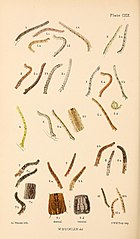Scopula nigropunctata
It is closely related to Scopula umbelaria but smaller, less whitish, the ground-colour being appreciably more testaceous and on an average more strongly dusted.
The forewing looks slightly shorter and broader, its distal margin being more strongly curved or bent in the middle so that its anterior part becomes less oblique; the black discal spot nearly always distinct, often large; the median shade, which in the typical form is strong and dark, and the postmedian line are both angled near the costa of the forewing, and the former runs rather more obliquely than in umbelaria; the hindwing has the angle in the middle rather stronger on the average, though very variable; both wings have usually a dark terminal line, interrupted at the vein-ends and often thickened between; the black dots in the fringe are very slight or are wanting.
In China and Japan, however, with Korea and probably S. E. Siberia, occur a succession of more puzzling forms, extremely variable in size and shape, in ground-colour and in distinctness of marking.
The larva is very slender, tapering slightly anteriorly the head rounded, skin transversely ribbed, the spiracles very small, brown; the general colour is greenish grey with a narrow, distinct dull green dorsal line; on the extreme anterior edge of each of the middle segments there is a square black spot, divided down its centre by the dorsal line.
The pupa has six minute hooks on the cremaster in addition to the strong pair of central spines.
